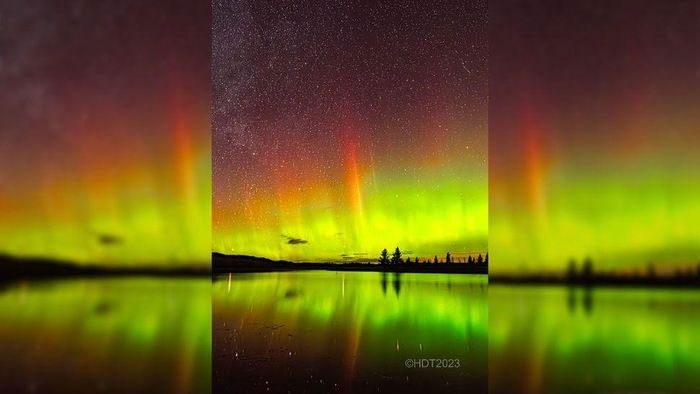A recent solar storm struck Earth, creating bright orange pillars dancing in the night sky over Canada.
Experts noted that these images captured a rare combination of red and green light, not seen since the infamous Halloween solar storm hit Earth 20 years ago.

Orange aurora captured on October 19 in Alberta, Canada. (Photo: Harlan Thomas).
Aurora photographer Harlan Thomas captured this colorful image on October 19 in the western part of Calgary, Alberta, about three days after the sun released a coronal mass ejection (CME) moving slowly toward Earth.
The auroras are produced when high-energy particles from the CME or solar wind penetrate Earth’s magnetic field or magnetosphere and excite thermospheric gas molecules in the upper atmosphere. The excited molecules release energy in the form of light, with the color depending on which element is stimulated. The two most common aurora colors are red and green, both emitted by oxygen molecules at different altitudes (red auroras are created at higher altitudes than their green counterparts). However, when solar particles penetrate deeper into the atmosphere, they can also trigger rare pink auroras by exciting nitrogen molecules.
In theory, both oxygen and nitrogen molecules can emit orange wavelengths under specific conditions. However, even if this occurs, the orange color is often overshadowed by other colors produced by surrounding molecules, making it difficult to see these wavelengths in reality.
Kjellmar Oksavik, a space weather scientist and aurora expert at the University of Bergen in Norway, stated: “There may be a combination of the red and green auroral processes, leading cameras and the human eye to perceive it as orange. In fact, it has both red and green at the same time.”
While red and green auroras frequently appear together in the sky, orange auroras are quite rare. The most visible orange occurs at the center of large auroral beams—vertical columns of light aligned along invisible magnetic field lines—formed from both red and green light, making this phenomenon uncommon, Oksavik added.
The last time such vibrant pumpkin-like colors were observed was during the Halloween storm of 2003, the strongest solar storm in modern history. During this grand event, orange light was detected across North America and Northern Europe.





















































